Dubai: Protesting farmers in India were locked in a pitched battle with the police in Delhi on January 26, raising questions about where the agitation is heading.
Hundreds of protesters marched to the Red Fort last week and at one point the Nishan Sahib, a Sikh religious flag, was hoisted atop one of the domes at the 17th century, red sandstone edifice.
Will it mark a departure from the largely peaceful demonstrations against the government which began in November 2020 when 40 farmers’ unions formed the Samyukta Kissan Morcha (Joint Farmers Front)? They are demanding a complete rollback of three contentious new laws in the latest farm legislations introduced by the federal government.
Will the violence result in breaking the unity of the farmers?
Here’s a look at what the protests are about, what happened in Delhi on January 26 and what lies ahead.
Who is protesting?
Most of the protesters are farmers from northern Punjab and Haryana states, the two biggest agricultural producers. They are demanding the repeal of laws passed by Parliament in September that they say will favour large corporate farms, devastate the earnings of many farmers and leave those who hold small plots behind as big corporations win out. The government has billed the laws as necessary to modernise Indian farming.
Because of the demographics of Punjab and Haryana, many of the protesters in New Delhi happen to be Sikhs, though their grievances are rooted in economic issues, not religious ones. Protests are also happening in other parts of the country.
What are their concerns?
At the heart of these protests are Indian farmers’ fears that the government’s moves to introduce market reforms to the farming sector will leave them poorer.
The new legislation is not clear on whether the government will continue to guarantee prices for certain essential crops - a system that was introduced in the 1960s to help India shore up its food reserves and prevent shortages.
While the government has said it is willing to pledge the guaranteed prices will continue, the farmers are skeptical and want new legislation that says such prices are their legal right.
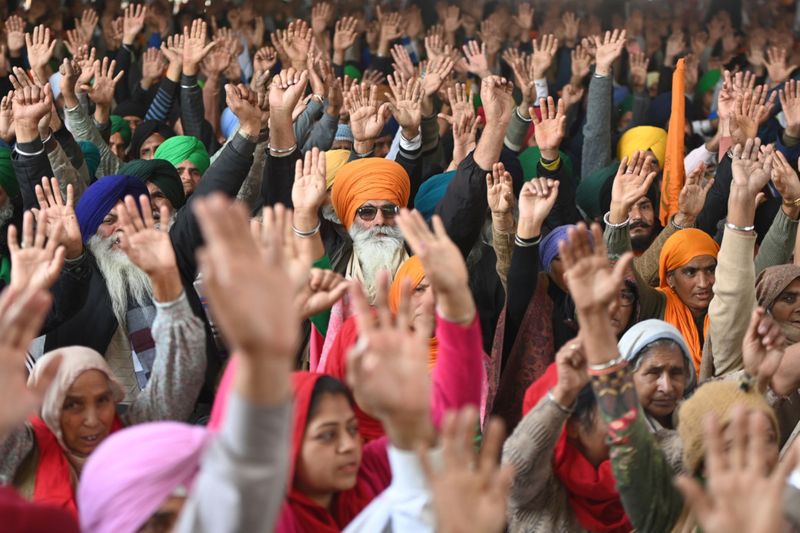
Farmers also fear that the legislation signals the government is moving away from a system in which an overwhelming majority of farmers sell only to government-sanctioned marketplaces. They worry this will leave them at the mercy of corporations that will have no legal obligation to pay them the guaranteed price anymore.
The government argues that this is designed to give farmers more choice in who to sell their produce to.
Clauses in the legislation also prevent farmers from taking contract disputes to courts, leaving them with no independent means of redress apart from government-appointed bureaucrats.
These perceived threats to their income terrify India’s farmers, who are mostly smallholders: About 68% of them own less than 2.5 acres of land. In some states, farming families earn just Rs20,000 ($271) on average annually.
Why are the protests significant?
Farmers form a very influential voting bloc in India. Since the legislation was passed, the BJP has lost two political alliance partners and some leaders are cautioning the government to tread carefully.
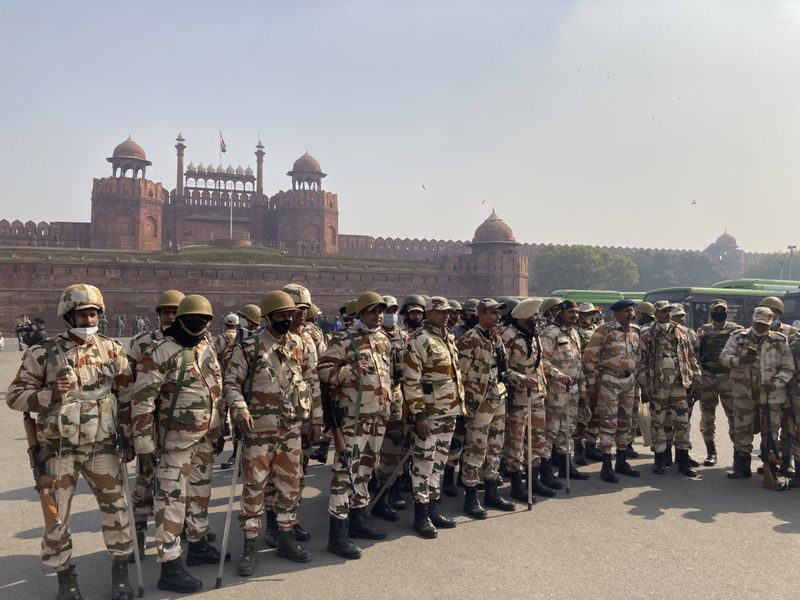
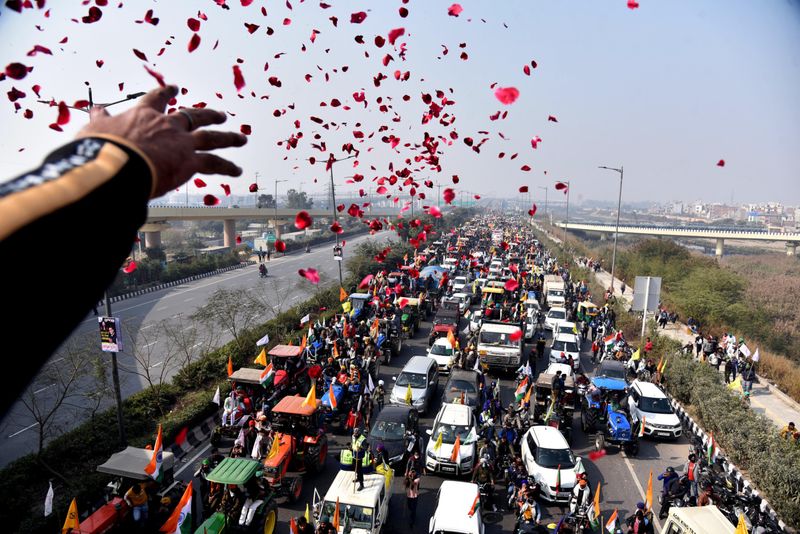
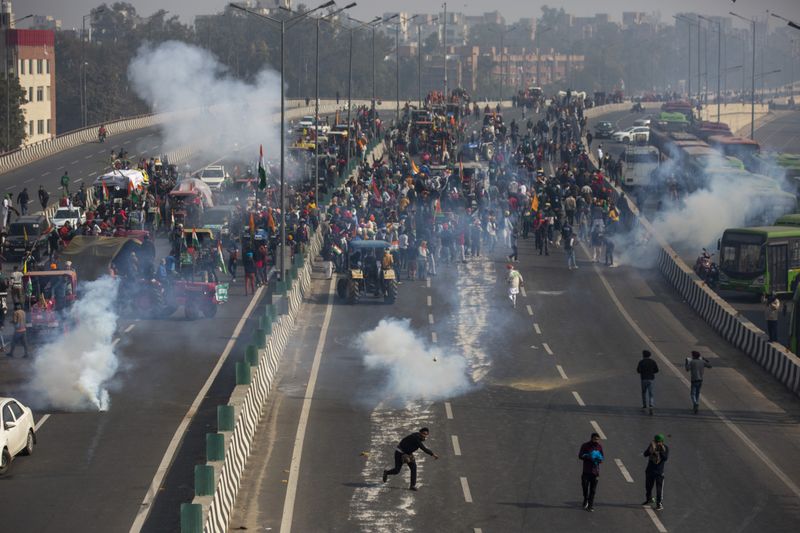
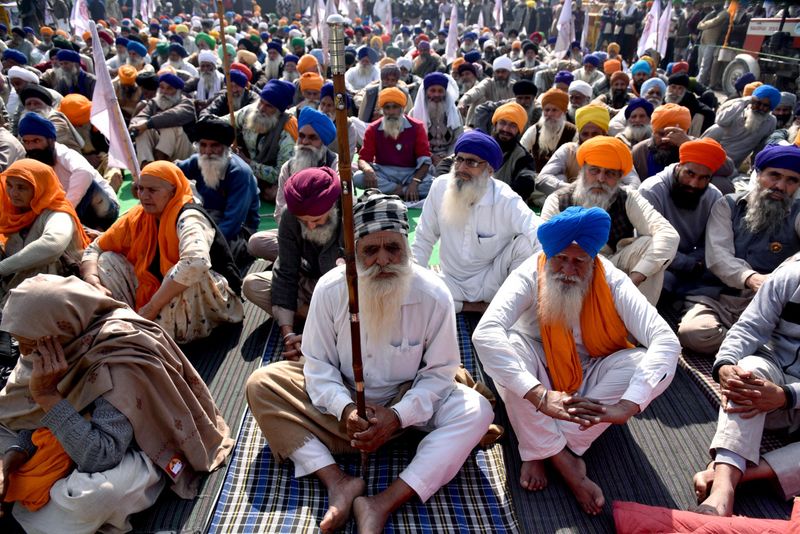
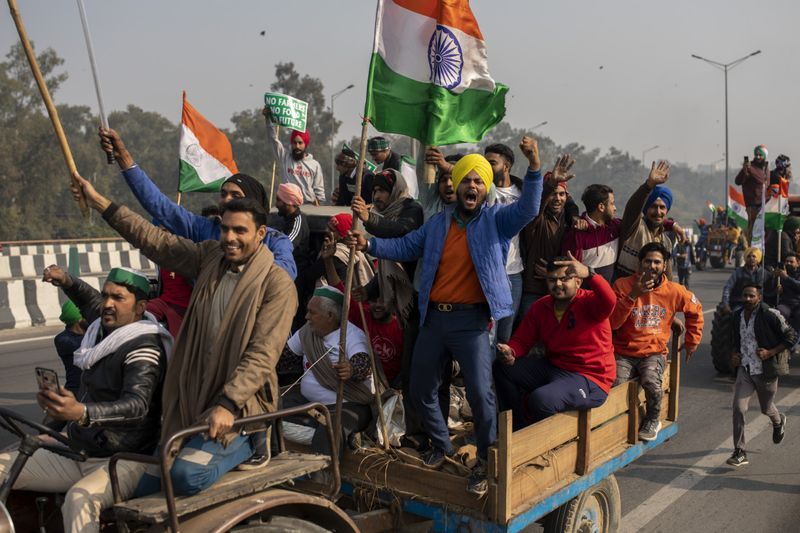

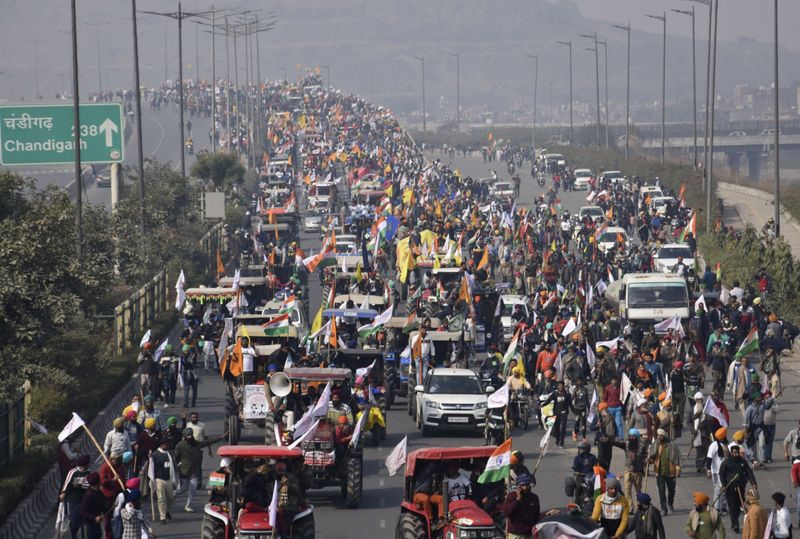
What is the government saying?
The BJP government says the legislation will benefit farmers by boosting production through private investment.
The government has offered to amend the laws and suspend their implementation for 18 months - but that has not satisfied farmers who want a full repeal.
Many agriculture experts agree that the Indian farming sector needs reforms, but they question the way the laws were introduced and the corporate involvement in agriculture.
Critics also highlight what they see as the government’s tendency to push through reforms without building consensus.
What happened on January 26 in Delhi?
The farmers’ lobby, Samyukta Kissan Morcha (SKM) had sought permission to bring out a peaceful tractor rally on the streets of Delhi. A court order was granted, but only on a clearly-designated, pre-determined route. However, trouble started when swathes of farmers in these tractors started deviating from the designated route and began entering areas that were not at all demarcated for the rally. Apart from triggering a massive traffic chaos in parts of Delhi, the tractors triggered large-scale panic and threw the traffic system in large parts of Delhi completely off gear. Soon there were ugly scenes of violence between the farmers and the men in uniform at Nangloi, ITO and the areas adjoining the Red Fort.
In the violence, one farmer was killed as his tractor overturned, while more than 300 police personnel were injured.
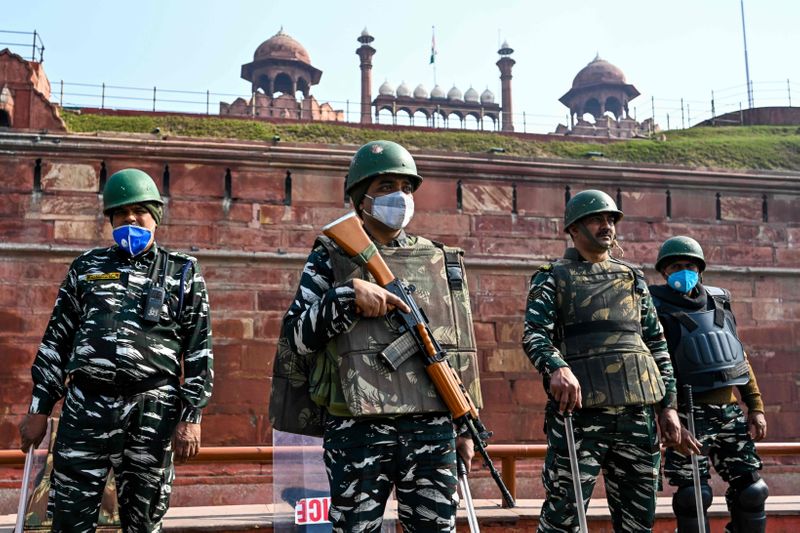
The worst scenes of violence were seen in Red Fort when groups of men were seen scaling the Red Fort perimeter wall and a section of the mob hoisted a religious flag atop one of the Red Fort domes. Fifteen companies of paramilitary forces were deployed on the streets of Delhi as there were dangers of the violence spilling over to central Delhi where the Republic Day parade was being held in the presence of a large number of guests and dignitaries with the president and prime minister also in attendance.
Six Delhi Transport Corporation buses and five police vehicles were damaged in the violence. An FIR lodged by Delhi Police also mentioned that 70 iron barricades put up by the police were damaged as 600 tractors stormed Delhi roads.
By evening, the violence was brought under control and the protesting farmers who had entered Delhi retreated to the original protest site at Singhu, on the Delhi-Haryana border.
Questions were raised on whether the sudden violence in Delhi was entirely the handiwork of a bunch of protesting farmers or whether mischievous elements had infiltrated the movement to malign the farmers’ agitation and break the unity.
What is the fallout?
The agitation by the farmers now faces its first big challenge in terms of unity and cohesion. Already two farmer unions have pulled out of the protests. Rashtriya Kisan Mazdoor Sangathan (National Farm Workers’ Union) leader V.M. Singh announced on Wednesday that his outfit was withdrawing from the protests. “I can’t carry forward the protest with someone whose direction is different,” V.M. Singh said.
Another union, the Bharatiya Kisan Union (Indian Farmers’ Union) has also announced its withdrawal from the agitation. “I am deeply pained by whatever happened in Delhi … and ending our 58-day protest,” Thakur Bhanu Pratap Singh, the president of Bharatiya Kisan Union, announced.
What is actually more worrisome right now for the protesting farmers’ lobby is that the violence in Delhi on January 26 can actually trigger a ripple effect in the movement and see many more units walk out of the Samyukt Kisan Morcha (Joint Farmers’ Front). For instance, V.M. Singh, the Rashtriya Kisan Mazdoor Sangathan leader, has issued a statement blaming Bharatiya Kisan Union’s Rakesh Tikait for pressurising the farmers to deviate from the designated and court-mandated route during the tractor rally on January 26, thereby contributing to the chaos and the eventual violence.
There have so far been 11 rounds of talks between the federal government and the farmers’ lobby, but a solution to the impasse is yet to be worked out.
What is the future of the protest movement?
While for the farmers’ body, the challenge now is to keep their stock together and keep pressing for their demands, for the government, any sign of disunity among the agitating farmer unions will offer an opportunity to try and get a foot in the door and win over sections of protesting farmers, take them into confidence and broker some sort of a rapprochement at the earliest.
The farmers’ lobby, Samyukta Kisan Morcha, has now threatened to take out a protest rally on Parliament Street in New Delhi on February 1, the day the federal government presents its annual budget. Apart from that, several farmers’ unions said they had mobilised farmers and sympathisers in states such as West Bengal, Maharashtra, Tamil Nadu, Andhra Pradesh, Madhya Pradesh and Bihar to try and extend the protests pan-India.
If this scenario continues then in the near future, a certain amount of fatigue is bound to set in among the protesting farmers and the movement will then be in danger of getting splintered into many factions and ultimately fizzling out.
What is the controversy over the violence?
The unruly scenes on the streets of Delhi on Republic Day have further worsened the trust-deficit between the agitating farmers and the federal government. A vast section of the farmers’ lobby has claimed that the January 26 mayhem in Delhi was triggered and instigated by hoodlums who had nothing to do with the farmers’ agitation. The BJP has said that it had nothing to do with the instigators of violence. FIRs have been lodged by Delhi Police against Deep Sidhu, a Punjabi actor-turned-activist who has been accused of instigating farmers to storm the Red Fort and hoist a religious flag atop one of the domes. Apart from Sidhu, FIRs have also been lodged against 37 farmer union leaders such as Rakesh Tikait, Yogendra Yadav, Darshan Pal and Gurnam Singh Chaduni.
The farmers’ lobby has claimed that the presence of “anti-social” elements like Sidhu during the Republic Day violence on the streets of Delhi was a clear sign of his connivance with a section of the ruling party. They have even cited Sidhu’s pictures taken earlier with Sunny Deol, Bollywood star and BJP MP from Gurdaspur, Punjab. Deol, though, has denied having any link with Sidhu beyond occasional chance encounters at social gatherings.
Names linked to the protest
Samyukt Kissan Morcha (Joint Farmers’ Front): This is the prime lobby that is organising the farmers’ protests at Singhu on the Delhi-Haryana border for the last two months. It is made up of 40 farmers’ unions. This front was formed in November 2020 to protest the three new farm laws and to press the federal government with their demands for a complete repeal of these laws.
Kawalpreet Singh Pallu, one of the key union leaders, said the violence in Delhi on January 26 will not deter the farmers’ agitation and he threatened to hold a protest demonstration in Delhi on February 1,when the federal government will be presenting its annual budget.
Deep Sidhu: The Punjabi actor suddenly finds himself in the eye of a storm. In a social media post on January 26, Sidhu was seen instigating the mob to raise a religious flag atop the Red Fort, even as the tractor rally turned violent and a section of protesting farmers fought a pitched battle with Delhi Police in and around the Red Fort and other parts of Delhi.
While some Opposition parties have accused the ruling BJP of trying to derail the farmers’ agitation by using Sidhu to instigate violence, the BJP has distanced itself from Sidhu, saying it had absolutely no relations with him. According to Delhi Police, an FIR had been lodged against Sidhu.
Sunny Deol: The BJP Member of Parliament from Gurdaspur, Punjab, was seen defending himself on social media, denying any formal links with Deep Sidhu. It was alleged in a section of social media that Deol was hand-in-glove with Sidhu.
Two weeks ago, both Deol and Sidhu were summoned by the National Investigation Agency for questioning about their reported connection with a sedition case against Sikhs for Justice - a banned pro-Khalistan movement based in the United States. Both Sidhu and Deol have denied having any links with the group.
Rakesh Tikait: The national spokesperson for Bharatiya Kisan Union suddenly finds himself in the eye of a storm. Delhi Police’s FIRs against 37 farmer leaders over the January 26 violence in Delhi includes Tikait’s name. However, on Thursday, the leader said: “Our protest will continue and we will not take responsibility for whatever happened at Red Fort on January 26.”
However, a controversy has erupted over Tikait’s alleged role in the violence with a leader of one of the farmers’ unions holding him responsible. V.M. Singh, the Rashtriya Kisan Mazdoor Sangathan leader, has issued a statement blaming Tikait for pressurising the farmers to deviate from the designated route during the tractor rally on January 26, thereby triggering the chaos and the eventual violence.
- with inputs from AP
from World,Europe,Asia,India,Pakistan,Philipines,Oceania,Americas,Africa Feed https://ift.tt/39om02y


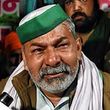
No comments:
Post a Comment